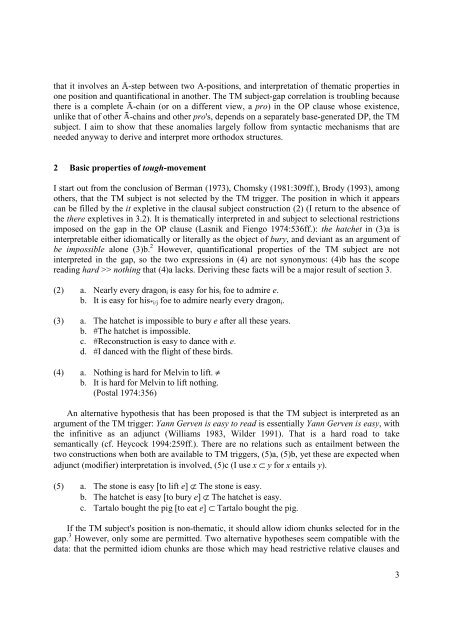1 On tough-movement* Milan Rezac, University ... - Multimania.co.uk
1 On tough-movement* Milan Rezac, University ... - Multimania.co.uk
1 On tough-movement* Milan Rezac, University ... - Multimania.co.uk
You also want an ePaper? Increase the reach of your titles
YUMPU automatically turns print PDFs into web optimized ePapers that Google loves.
that it involves an Ā-step between two A-positions, and interpretation of thematic properties in<br />
one position and quantificational in another. The TM subject-gap <strong>co</strong>rrelation is troubling because<br />
there is a <strong>co</strong>mplete Ā-chain (or on a different view, a pro) in the OP clause whose existence,<br />
unlike that of other Ā-chains and other pro's, depends on a separately base-generated DP, the TM<br />
subject. I aim to show that these anomalies largely follow from syntactic mechanisms that are<br />
needed anyway to derive and interpret more orthodox structures.<br />
2 Basic properties of <strong>tough</strong>-movement<br />
I start out from the <strong>co</strong>nclusion of Berman (1973), Chomsky (1981:309ff.), Brody (1993), among<br />
others, that the TM subject is not selected by the TM trigger. The position in which it appears<br />
can be filled by the it expletive in the clausal subject <strong>co</strong>nstruction (2) (I return to the absence of<br />
the there expletives in 3.2). It is thematically interpreted in and subject to selectional restrictions<br />
imposed on the gap in the OP clause (Lasnik and Fiengo 1974:536ff.): the hatchet in (3)a is<br />
interpretable either idiomatically or literally as the object of bury, and deviant as an argument of<br />
be impossible alone (3)b. 2 However, quantificational properties of the TM subject are not<br />
interpreted in the gap, so the two expressions in (4) are not synonymous: (4)b has the s<strong>co</strong>pe<br />
reading hard >> nothing that (4)a lacks. Deriving these facts will be a major result of section 3.<br />
(2) a. Nearly every dragon i is easy for his i foe to admire e.<br />
b. It is easy for his *i/j foe to admire nearly every dragon i .<br />
(3) a. The hatchet is impossible to bury e after all these years.<br />
b. #The hatchet is impossible.<br />
c. #Re<strong>co</strong>nstruction is easy to dance with e.<br />
d. #I danced with the flight of these birds.<br />
(4) a. Nothing is hard for Melvin to lift. ≠<br />
b. It is hard for Melvin to lift nothing.<br />
(Postal 1974:356)<br />
An alternative hypothesis that has been proposed is that the TM subject is interpreted as an<br />
argument of the TM trigger: Yann Gerven is easy to read is essentially Yann Gerven is easy, with<br />
the infinitive as an adjunct (Williams 1983, Wilder 1991). That is a hard road to take<br />
semantically (cf. Hey<strong>co</strong>ck 1994:259ff.). There are no relations such as entailment between the<br />
two <strong>co</strong>nstructions when both are available to TM triggers, (5)a, (5)b, yet these are expected when<br />
adjunct (modifier) interpretation is involved, (5)c (I use x ⊂ y for x entails y).<br />
(5) a. The stone is easy [to lift e] ⊄ The stone is easy.<br />
b. The hatchet is easy [to bury e] ⊄ The hatchet is easy.<br />
c. Tartalo bought the pig [to eat e] ⊂ Tartalo bought the pig.<br />
If the TM subject's position is non-thematic, it should allow idiom chunks selected for in the<br />
gap. 3 However, only some are permitted. Two alternative hypotheses seem <strong>co</strong>mpatible with the<br />
data: that the permitted idiom chunks are those which may head restrictive relative clauses and<br />
3
















